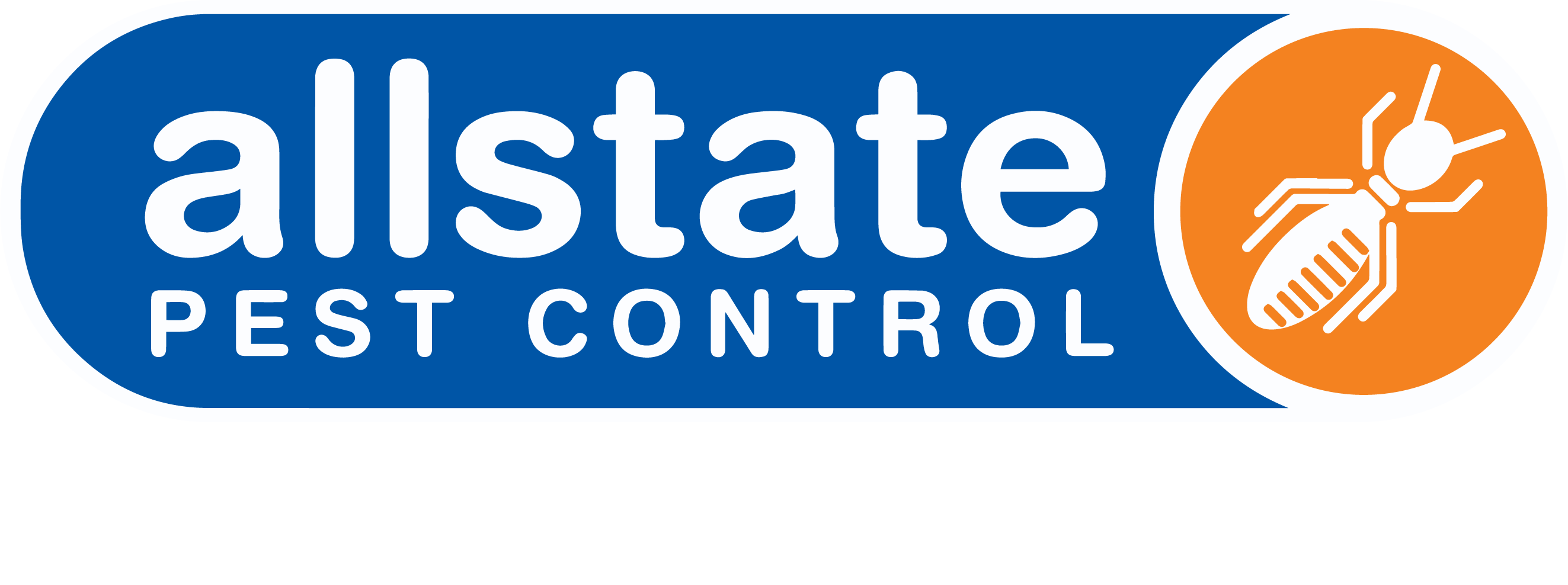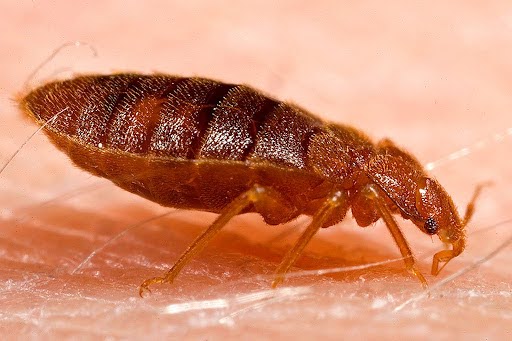
by seo | Jul 31, 2025 | Bed Bug
So, how do you treat bed bug bites?
Start by washing the affected skin with soap and water. Apply a cold compress. Use an anti-itch cream or calamine lotion. And avoid scratching, no matter how tempting.
If the bites worsen or signs of infection appear (which is rare), speak to your doctor. Some cases may need antihistamines or prescription creams.

At Allstate Pest Control, we’ve helped thousands of South Australians manage bed bug problems and infestations for over 35 years. We’re here to guide you, step by step, through relief, remedies, and long-term prevention.
Let’s walk you through what to do.
What Do Bed Bug Bites Look Like?
Bed bug bites usually appear as red, raised welts. You’ll often find them in clusters or lines on exposed skin of the arms, legs, neck, or back.
Unlike spider bites, they don’t swell up immediately. They can take hours or even days to show. And once they do? The itching kicks in.
The bite marks can become inflamed, especially if you scratch at them. On brown skin, bites may appear as darkened or purple spots rather than red.
What makes things tricky is that not everyone reacts the same way. Some people experience severe itching or even an allergic reaction. Others barely notice the bites at all.
Bed Bug Bites: How to Treat
- First step: clean the area. Gently wash the bite marks with soap and lukewarm water. This helps prevent skin infections and soothes the itch somewhat.
- Apply a cold compress. It reduces swelling and numbs the itch. Don’t scratch, it spreads bacteria and delays healing.
- Next, use an over-the-counter cream or gel like calamine lotion or hydrocortisone. These reduce inflammation and provide relief from severe itching.
- If the bites are widespread or you’re having a stronger reaction, speak to your GP or pharmacist. They may recommend an oral antihistamine or prescription topical cream.
Home Remedies for Bed Bug Bites: Quick Relief Tips
Got no creams on hand? No worries.
Here’s how to treat bed bug bites with what’s already in your kitchen or medicine cabinet.
Topical treatments for itching and swelling
- Aloe vera gel: Straight from the plant or a natural gel. Soothes, hydrates, and promotes healing.
- Tea tree oil: A few drops diluted in water or carrier oil help with itching and have antibacterial properties.
- Baking soda paste: Mix with a few drops of water and dab it on. Leave for 15 minutes, then rinse.
- Toothpaste: Surprisingly effective. The menthol provides a cooling effect and reduces irritation, but avoid using it on broken skin.
When to seek medical help for bed bug bites
Get medical advice if:
- You develop a fever.
- The bite area feels warm, hard, or has pus (signs of infection).
- You experience an allergic reaction, such as swelling of the face or trouble breathing.
Also see a GP if the bites aren’t healing after a few weeks or you’re constantly being bitten at home. That’s likely an ongoing bed bug infestation, not just a one-time problem.
How to Prevent Bed Bug Bites in the Future
The real problem isn’t the bites but the bugs.
To prevent bed bug bites, you need to prevente bedbugs or avoid them in the first place.
Here’s what helps:
- Avoid secondhand furniture, especially mattresses, bed frames, and upholstered items, without a pest check.
- Vacuum carpets, beds, and soft furnishings on a weekly basis. Pay extra attention to mattress seams and box springs.
- Use bed bug-proof covers on mattresses and pillows.
- Inspect your hotel room before unpacking. Pull back the bed sheets. Look at the seams. Check for tiny insects or black stains.
Worried you’ve picked them up during travel? Then, put all clothes and bags in a hot wash and dry cycle on the highest setting when you return.
Expert Bed Bug Removal Services from Allstate Pest Control
Treating bites is just the beginning. The only way to truly stop bed bug bites is to remove the bed bugs.
Allstate Pest Control offers safe, professional treatments tailored to your situation. Our licensed technicians inspect all possible hiding spots, from mattress seams and skirting boards to wardrobes and loose wallpaper.
We don’t rush the job. Our goal is to control bedbugs safely with targeted surface pesticide treatments, steam, or heat methods, depending on what your space needs.
We discreetly and effectively treat homes, hotels, aged care facilities, and student housing.
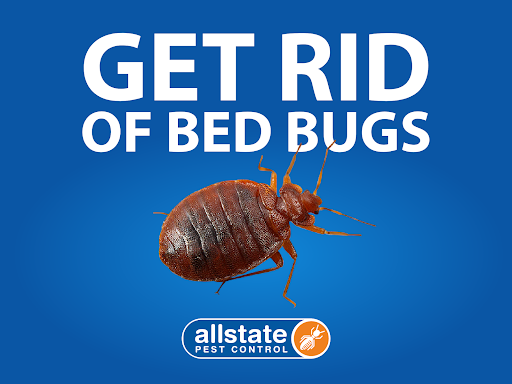
Contact Allstate Pest Control for Professional Bed Bug Treatments
Think you’ve been bitten? Seeing signs of a bed bug infestation at home or work?
Call Allstate Pest Control today on 08 8371 1277. We’re South Australia’s most trusted pest control company, available 24/7 for inspections and fast treatment plans. We’ll help you sleep easy again.
Frequently Asked Questions
What is the fastest way to heal bed bug bites?
The fastest way to treat bed bug bites is to wash the affected area with mild soap and water, apply calamine lotion or an antihistamine cream, and avoid scratching. Cold compresses help reduce swelling. Otherwise, leave the bite site alone. Most bites will heal on their own in a week or so.
How long does it take for bed bug bites to go away?
Bed bug bites usually heal in 7 to 14 days, or less. It depends on your skin type and whether you scratch. For some individuals, the itching can persist for several weeks.
What does toothpaste do for bed bug bites?
Toothpaste contains menthol and other cooling agents that can temporarily relieve itching. It’s not a medical treatment but can work in a pinch.
How do you stop bed bug bites from spreading?
You stop the spread by controlling the bed bug infestation. Regular cleaning, vacuuming, and professional pest control treatments are key. Bites themselves don’t spread, but repeated bites will occur until the bugs are removed.
Can bed bug bites cause serious problems if not treated?
In rare cases, untreated bed bug bites can lead to skin infections or allergic reactions. Sleep deprivation and stress are also common effects of ongoing infestations.
Need fast help with bed bug bites or a suspected bedbug infestation? Leave us a message or call Allstate Pest on (08) 8371 1277 today.
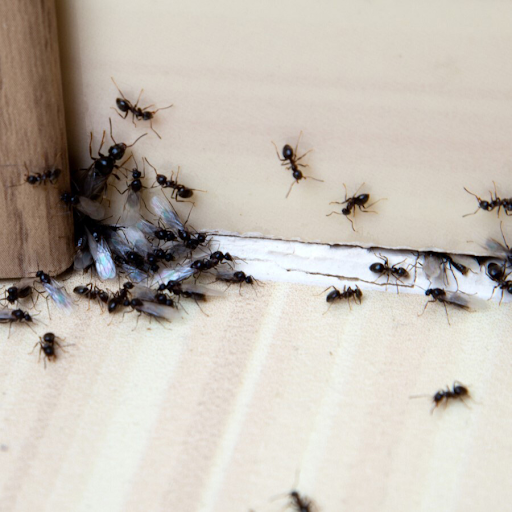
by seo | Jul 31, 2025 | Ants
Because your home has everything ants want, from food to water, and shelter.
That’s the short answer.
But if you’re seeing tiny ants marching across your benchtop or around the pet food bowl, there’s more going on under the surface.

At Allstate Pest Control, we’ve been helping South Australians tackle pest infestations for over 35 years. We handle emergency call-outs, long-term treatments, and prevention plans for both homes and businesses. And when it comes to ant control, we’ve seen it all, from sugar trail scouts to full-blown carpenter ant infestations hiding behind the wall.
Let’s help you find out why ants invade homes, what attracts ants inside, and how you can stop ants from coming back.
Why Do I Keep Getting Ants in My House?
Because they’ve found a food source or water, and told their colony.
Ants don’t wander in randomly. Worker ants go out to search for food or moisture. Once they find something, like a crumb, a leaky pipe, or a pet bowl, they leave behind a chemical trail. This trail guides the other ants directly to it.
Most ants come inside looking for:
- Sweet foods (think honey, sugar, juice spills)
- Greasy leftovers or meat scraps
- Water from leaky taps, condensation, or plant trays
- Shelter from rain or extreme heat
Why Do Ants Come Inside When It’s Hot?
During hot seasons, such as summer, ants are more likely to invade homes.
Why?
When it’s hot and dry, ants come inside to escape the heat and search for water. Ant activity increases during warm months, especially for pavement ants and other ground-dwelling species common in Australia.
Once the colony finds a reliable food source, you’ll notice ants walking in steady lines across the floor, benchtop, or windowsill. That’s your cue to act fast.
What attracts ants inside the home?
Ants love it when you have a messy kitchen, dining room or living room in any form.
They’re drawn to sugary substances, food residue, and anything not appropriately sealed. Even the tiniest crumb under your toaster can be enough to trigger an ant infestation.
Here’s what attracts ants:
- Unsealed food like cereal, rice, or snacks
- Fruit left out on the counter
- Spills straight from soft drinks or juice
- Pet food bowls left out overnight
- Poorly sealed windows, cracks, or entry points
- Damp areas like under sinks or laundry rooms
Carpenter ants may also enter your home if there’s rotting or damp timber. Unlike other ants, they don’t eat wood, but they hollow it out to create nesting habitats.
How to Stop Ants from Coming Inside My House: 7 Things to Do

If you’ve had ants invading your kitchen more than once, it’s time to break the cycle. Here’s what to do.
Identify the type of ant
Different ants need different treatment methods. Some ants are sweet lovers.
Others prefer grease or protein. Some build nests in walls (like carpenter ants).
Others stay outdoors but forage inside. Identifying the ant species helps choose the right bait or barrier.
Keep surfaces clean
Wipe down benchtops after every meal. Mop floors regularly. Don’t leave dirty dishes overnight. Even a small spill can trigger an ant trail. Pay attention to hidden spots like under the fridge, toaster, or microwave.
Store food in sealed containers
Use airtight containers for sugar, beverages, flour, grains, and snacks. Don’t rely on cardboard packaging. Ants can chew through it. The same goes for pet food; store it in sealed containers and clean bowls daily.
Seal cracks
Inspect your walls, windows, doors, and skirting boards. Use sealant to block gaps. Fix poorly sealed windows or broken flyscreens. If ants are coming through a specific crack, you’ll often see them forming a line there.
Use ant baits
Ant bait is more effective than sprays in the long run. Worker ants carry the bait back to the colony. It poisons the entire nest over time.
Ensure the bait matches the ants’ food preference; some prefer protein, while others prefer sugar. Always follow the label instructions.
Use an ant spray barrier
Apply non-repellent ant spray along door frames, windows, and exterior walls. These products allow ants to walk through and carry the toxin back to the colony without alerting others.
Avoid strong-smelling repellents, as they can cause the ants to split and form new colonies.
Turn to pest control professionals
If ants keep returning, it’s time to call an ant control professional. At Allstate Pest Control, we use targeted treatments that prevente the entire nest, not just the visible ants. We also identify access points and prevent ants from coming back.
How Do I Know If I Have Termites or Ants?
Not all ants are harmless, and not every wood-loving insect is a termite.
If you see small piles of sawdust, hollow-sounding timber, or ants with wings, it could be something more serious. Carpenter ants are often mistaken for termites, but they don’t eat wood; they dig into it. Termites, on the other hand, feed on cellulose and cause structural damage.
A licensed pest control expert can confirm what pest you’re dealing with. Don’t guess, especially if you own a timber-framed home.
Frequently Asked Questions
Why are there ants in my house suddenly?
Ants appear suddenly when they discover food or water. Once a worker ant finds it, others quickly follow via a scent trail. This can happen within hours of a spill or leak.
What do ants hate most?
Ants dislike strong scents, such as lemon juice, peppermint oil, and vinegar. But these are only short-term deterrents. Professional pest control methods target the nest directly for more effective and longer-lasting results.
Does killing ants attract more?
Yes, in some cases. Crushing ants releases alarm pheromones that can attract other ants to the area. It’s better to use ant bait to target the entire colony discreetly.
Why are there ants in my room but no food?
Even if you don’t see food, ants may detect food residue, pet food, or moisture. Sometimes ants use rooms as pathways to other areas. Check windows, skirting boards, and power outlets.
How to manage ants when you don’t know where they’re coming from?
Start with deep cleaning. Remove all food sources. Use ant bait along ant trails or suspected areas. If the problem persists, contact a licensed pest control expert to locate the nest and apply a comprehensive treatment.
If ants have become a constant battle, don’t wait until the colony grows.
Call Allstate Pest Control on (08) 8371 1277 or send us a detailed message about the situation to book an inspection or emergency treatment. We’re trusted by thousands of South Australians, and we’re ready to help you protect your home.

by seo | Jul 31, 2025 | Possum
Yes, possums can be dangerous, though not in the way most people think. They’re not naturally aggressive. But when cornered, a possum may bite, scratch, or spread harmful diseases through droppings and parasites.

At Allstate Pest Control, we’ve protected thousands of homes and businesses in South Australia for over 35 years. We’re trusted by families, schools, and councils across Adelaide to handle wildlife pests, especially the sharp-clawed, nest-building kind. Possums included.
Let’s break it all down for you. What possums do, why they act out, and what you should never do if you spot one in your backyard or roof cavity.
What Are Possum Defensive Behaviours?
If a possum feels threatened, it won’t go down quietly.
It might growl, hiss, or bare its teeth. It may even lunge.
That’s not because a possum is inherently dangerous. It’s simply scared.
Possums, especially common brushtail possums, are prey animals. They’re wired to defend themselves from predators like owls, dogs, or humans. When backed into a corner, they might:
- Bite with sharp teeth
- Scratch with strong claws
- Release a foul-smelling liquid
- Or “play dead” to escape.
It’s nature’s panic button, and it can get messy.
Also Read: What Does Possum Look Like?
Do Possums Pose Health Risks to Humans?
Yes, they do.
Direct contact or exposure to possum droppings and urine can pose real health risks.
Possums may not attack unprovoked, but they carry parasites and bacteria that don’t belong in your ceiling or kitchen.
What Diseases Can Possums Spread?
Here’s where it gets serious. According to research and local wildlife experts:
- Leptospirosis can spread through the urine of certain animals, such as possums, especially in damp roof spaces.
- Salmonella has been found in possum droppings, which can contaminate surfaces and food.
- Mites, ticks, and fleas that live on possums can be transferred to pets or humans.
- Possums are known to be reservoirs for buruli ulcers, a flesh-eating bacterial infection, although it’s rare.
While possums look cute, they’re still wild animals. Handling them without gloves or letting kids play near possum nesting material is risky.
Why Do Humans Get Bitten by Possums?
It’s not common, but it happens. Most possum bites occur when someone tries to pick one up, block its exit, or disturb its nest boxes.
Possums have up to 50 teeth, which is more than other mammal. So, they are good at giving a bite.

Brushtail possums may live in your roof, garage, or shed, especially if there’s warm insulation, nesting material, or easy access to pet food. And if you accidentally corner one?
It’ll fight its way out.
Possums don’t go looking for a fight, but they won’t back down when they feel threatened. Keep kids, pets, and curious fingers away from their hiding spots.
How to Prevent Negative Interactions with Possums
Possums are a common sight in South Australia. So, rather than panic, take preventative steps.
Here’s how to keep the peace between humans and possums:
- Remove food sources, such as open compost bins, fallen fruit trees, or pet food, from verandas.
- Block entry points in your roof, wall vents, and eaves. Possums love a cosy roof space.
- Trim trees near your roofline to reduce access. They can leap 2–3 metres if needed.
- Avoid confrontation. Never try to trap or move one yourself.
- Install nest boxes in your yard to redirect them away from your ceiling.
If you ever need help with roof inspections, sealing or possum removal in Adelaide? Allstate Pest Control can sort that out quickly. Call us on 08 8371 1277.
What to do if a possum enters your home
First, stay calm.
Second, don’t touch it.
Turn off the lights and leave a door or window open. Give it space to escape on its own.
If it refuses to leave or appears distressed, contact a licensed wildlife handler or pest control service, such as Allstate Pest Control. Trapping common brushtail possums is regulated in South Australia. They can’t be relocated more than 50 metres and must be released safely near their capture site.
Who can trap common brushtail possums?
In South Australia, only licensed wildlife handlers can trap or relocate possums.
According to the Australian Department for Environment and Heritage, it’s illegal to kill or move a possum without permission under the National Parks and Wildlife Act 1972.
At Allstate Pest Control, we collaborate with licensed professionals to ensure that every solution is safe, legal, and humane. We won’t harm your wildlife. We help control it with proper approvals.
Are Possums Dangerous or Misunderstood?
They’re mostly misunderstood.
Possums aren’t naturally aggressive or out to attack your kids or pets. But like all wild animals, they’ll defend themselves when they feel vulnerable.
They can carry diseases, cause roof damage, and trigger allergic reactions through their fur or faeces. In the wrong place, they’re a problem. In nature, they’re part of the ecosystem.
So no, not every possum is dangerous. However, a possum can be dangerous when cornered, sick, or living on your roof without permission.
The best course of action is to prevent them from nesting near you.
Frequently Asked Questions
Is it bad to have possums around your house?
It can be. Possums are wild animals. When near your roof, they may cause significant damage, especially if they chew insulation, scratch ducts, or urinate on your ceiling. They also attract predators, especially if you leave pet food out at night.
Are Australian possums dangerous?
Yes and no. Australian possums, such as the common brushtail possum, are protected wildlife. They’re not inherently dangerous, but they may scratch or bite if handled. Their droppings can spread disease, so it’s best to avoid direct contact.
What do you do if a possum approaches you?
Stay still. Don’t scream or run. Let it pass, and avoid blocking its escape route. If it doesn’t move, back away slowly. Then call a pest control professional at Allstate for help.
Will a possum try to bite you?
Only if it feels threatened. Possums generally avoid confrontation but will bite if cornered, scared, or picked up. Never attempt to remove one from your yard or roof without professional support.
Do possums nest in roof spaces or gardens?
Yes. They often seek dry, dark spaces, such as ceiling voids or sheds, especially when searching for nesting material. Possums may also settle in nest boxes in your garden if there are nearby trees and shelter.
Get Help Now. Call Pest Control
Still unsure whether the possum on your roof is harmless or a risk? Don’t guess. Get expert advice. Contact Allstate Pest Control or call 08 8371 1277 for safe, legal, and fast possum solutions. We’ll help you stay safe, avoid bites, and keep your home or business protected, 24/7.

by seo | Apr 24, 2025 | Pests
Carpet beetles might be tiny, but the damage they cause can be surprisingly big. From chewing through natural fibres to causing skin irritation, these oval-shaped insects are a nuisance and a sign that something deeper is going on inside your home.
Whether you’ve spotted a few crawling near your window sills, or you’re finding patchy damage on clothes or furniture, learning how to manage carpet beetles is the first step to reclaiming your space. In this guide, Allstate Pest Control walks you through everything from carpet beetle larvae to black carpet beetles. Additionally, we’ll see how to treat carpet beetles the right way.
What Are Carpet Beetles and Why Are They a Problem?

Carpet beetles are small, oval-shaped insects that belong to the family Dermestidae. In South Australia, the most common types include:
- Varied carpet beetles
- Furniture carpet beetles
- Black carpet beetles
Adult carpet beetles are often seen near window sills and light sources, but it’s the carpet beetle larvae you really have to watch out for. They’re the ones that cause most of the damage by feeding on natural fibres like wool, silk, leather, fur, feathers, and even animal hair.
Signs of a Carpet Beetle Infestation
If you notice any of the following, you could be dealing with a growing carpet beetle infestation:
- Shedding skins or “husks” from larvae
- Irregular holes in natural-fibre clothing, upholstery or rugs
- Live or dead carpet beetles near windows, doors, or vents
- Small clusters of carpet beetle eggs tucked into dark corners, spider webs, or behind upholstered furniture
- Signs of skin irritation in sensitive individuals
Household pests like carpet beetles are considered common pests in South Australian homes, especially during spring and summer when adult carpet beetles are actively breeding.
Understanding the Life Cycle of Carpet Beetles
To truly understand how to manage carpet beetles permanently, it helps to know their life cycle:
- Egg Stage: Females lay eggs in dark, undisturbed areas like inside air vents, under carpets, or in bird nests and dead animals.
- Larval Stage: Carpet beetle larvae hatch and begin feeding immediately on larval food such as dead insects, pet hair, wool, and even crumbs in the carpet.
- Pupal Stage: After weeks or months of feeding, larvae pupate in hidden spots.
- Adult Stage: Adult beetles emerge, usually to mate and find new egg-laying spots. Adults don’t do much damage, but they can still attract carpet beetles into your home.

How to Get Rid of Carpet Beetles Naturally
If you’re looking for how to manage carpet beetles naturally, that’s fine and you’re not alone. Many South Australian families prefer low-impact methods before resorting to chemical or professional treatments. Here’s where to begin:
1. Vacuum Regularly and Thoroughly
Start by vacuuming every surface possible, especially:
- Under rugs and carpets
- Around furniture joints
- Inside wardrobes and closets
- Along baseboards and skirting
Pay extra attention to areas where larvae prefer – dark, undisturbed zones. Dispose of the vacuum bag or empty the canister outdoors to avoid reinfestation.
2. Use Hot Water and Steam Cleaning
Hot water washes (above 60°C) are effective in handling both carpet beetle eggs and larvae. For non-washable surfaces, consider steam cleaning rugs, curtains, and furniture.
3. Seal Cracks and Use Insect Screens
Block out future beetles by sealing entry points and installing insect screens over vents and windows. Also, check for and remove any nearby bird nests or dead insects, which can be hidden sources of infestation.
4. Store Clothes and Fabrics Properly
Store off-season clothing in airtight containers, and avoid keeping natural fibres exposed for long periods, especially in storage rooms, lofts, or garages.
How to Get Rid of Carpet Beetles Permanently
When natural methods aren’t enough, professional treatment may be necessary to manage carpet beetles completely. Here’s a multi-step approach that can help:
1. Identify and Remove Sources
Locate and remove anything that could serve as a larval food source: old wool blankets, dead skin or pet hair buildup, or infested items from secondhand furniture.
2. Targeted Use of Insecticide Sprays
In South Australia, registered low-toxicity insecticide sprays can be used to treat areas where carpet beetles lay their eggs or where larvae feed. Always follow label instructions and never apply directly to clothing or bedding.
3. Professional Pest Control Services
If the infestation persists or spreads quickly, calling in carpet beetle experts like Allstate Pest Control can save you time and stress. With years of experience managing carpet beetle control in South Australian homes and businesses, our team uses safe, effective solutions tailored to your situation, especially when dealing with stubborn black carpet beetles or recurring outbreaks.
Preventing Future Carpet Beetle Infestations
Once you’ve dealt with the problem, don’t stop there. Prevent carpet beetles from coming back with these ongoing steps:
- Vacuum regularly, especially in corners, under furniture, and behind storage areas
- Avoid clutter that lets larvae enjoy dark spots to thrive
- Keep pet bedding clean and washed weekly
- Store wool, leather, and silk items in sealed containers
- Inspect secondhand furniture before bringing it home
- Check light fixtures, as adult carpet beetles are attracted to light
Frequently Asked Questions
What is the fastest way to manage carpet beetles?
The quickest way is to combine deep cleaning, hot water or steam cleaning, and targeted pest control treatments. If the infestation is widespread, professional services from Allstate Pest Control can speed up results.
Will vacuuming manage carpet beetles?
Vacuuming alone may not completely manage carpet beetles, but it’s essential for removing larvae, eggs, and potential food sources. It should be part of your ongoing prevention routine.
What do carpet beetles hate the most?
They dislike disruption, hot water, light, and clean environments. They also avoid strong-smelling natural deterrents like cedarwood and eucalyptus, though these work best alongside cleaning and sealing.
How do I know if I have a carpet beetle infestation?
Watch for signs like damaged natural fabrics, cast-off larvae skins, adult beetles around window sills, or small brown or black bugs crawling indoors.
Can I manage carpet beetles without chemicals?
Yes, using steam cleaning, vacuuming, and hot water washing can reduce small infestations. But for larger or persistent cases, professional carpet beetle control is more effective.
Final Thoughts: Trust South Australia’s Experts
Carpet beetles are sneaky and ruinous, but with the right approach, you can protect your home. Whether you’re dealing with a mild case of furniture carpet beetles or a full-blown carpet beetle infestation, Allstate Pest Control is here to help. Call us today for a free inspection, quote and advice tailored to your home or business.
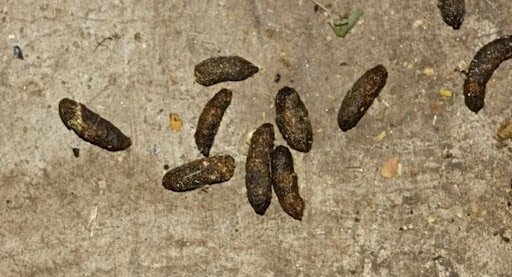
by seo | Apr 24, 2025 | Rats
Rats don’t need an invite to settle in, but they sure leave a trail when they do. One of the most telling (and frankly gross) signs of a rat infestation is the sudden appearance of rat poop in places you least expect—under sinks, behind cupboards, or near the pantry. But how do you identify rat poop, and more importantly, what should you do if you find it?
Allstate Pest Control takes a look at the murky world of rat poop, what it can tell you about the rodents living in your space, and how to deal with them safely.
What Does Rat Poop Look Like?
The appearance of rat poop can vary slightly depending on the species, diet, and how fresh the droppings are. Typically, rat feces are:
- About 12-18 mm long (roughly the size of a grain of rice)
- Spindle-shaped with rounded or slightly pointed ends
- Dark brown to black in colour
- Found in clusters of 30–50 pellets per day (yes, rats poop that much!)

The most common species of rats in Australian homes are the Norway rat and roof rat, and their droppings differ slightly in size and shape. Norway rat poop tends to be blunt at the ends, while roof rat poop is more tapered.
Wondering how big is rat poop compared to other animals? Possum droppings can look similar in size but are usually more clumped together and less tapered. On the other hand, mice droppings are significantly smaller—about 3–7 mm—and more pointed at both ends.
Does Rat Poop Smell?
Yes, and it’s not pleasant. Rat droppings and rat urine emit a strong musky smell, especially when there’s a large number of fresh droppings. That odour can linger in enclosed spaces and may be your first clue that rats are nesting nearby.
In addition to the unpleasant rat poop smell, their waste contains harmful bacteria that can contribute to poor indoor air quality and even pose serious health risks.
Is Rat Poop Dangerous? Understanding the Health Risks
Rat droppings are far from harmless; they can carry diseases and pathogens that pose health risks to both humans and pets. According to the New South Wales Health and other public health sources, exposure to rat faeces can lead to:
- Rat bite fever: A bacterial infection that can occur through direct contact with rat feces or contaminated food. Symptoms include flu-like symptoms, muscle aches, vomiting, and rash.
- Leptospirosis: A bacterial disease spread through rat urine or contaminated water. It can lead to kidney or liver damage.
- Salmonellosis: Spread by contaminated food or water, this infection causes diarrhoea, fever, and stomach cramps.
- Lymphocytic choriomeningitis (LCMV): A viral disease carried by rodents. Infection can result in neurological symptoms and severe complications during pregnancy.
- Hantavirus renal syndrome and hemorrhagic fever: Though rare in Australia, these are risks in areas where rodent populations surge.
- Historical diseases like bubonic plague may seem outdated, but yes, it’s historically linked to rat waste and fleas.
Beyond infectious diseases, rat droppings may trigger allergic reactions or worsen asthma, especially in children. It’s essential to take them seriously.
How to Identify Rat Poop in Your Home
Knowing how to identify rat poop can help you act quickly. Here’s what to look for:
- Quantity: Rats defecate frequently. Finding a lot of droppings in a small area? That’s a red flag.
- Location: Find rat poop near food sources, walls, roof voids, or under furniture.
- Fresh vs old: Fresh rat poop is shiny and soft, while old droppings are dry, crumbly, and dull. This can tell you if the infestation is active.
- Dropping size: Larger droppings likely mean adult rats, while smaller droppings could mean babies—or mice.
What To Do When You Find Rat Droppings
Rat droppings aren’t just gross—they require immediate and safe attention. Here’s how to clean them up without risking your health:
Step 1: Wear protective gear
Before handling any animal feces, make sure to put on rubber gloves, a dust mask, and even plastic gloves if needed. This prevents contact with harmful bacteria or airborne particles from dry droppings.
Step 2: Ventilate the area
Open windows and doors for at least 30 minutes before cleaning, especially in enclosed spaces.
Step 3: Do not sweep or vacuum
Sweeping can spread tiny droplets of bacteria and pathogens into the air. Instead, spray the area with a household bleach or bleach solution (1 part bleach to 10 parts water) and let it sit for 5 minutes.
Step 4: Wipe and dispose
Use a paper towel to pick up the droppings, and dispose of it in a plastic bag. Seal it tightly and throw it into a covered garbage bin that’s regularly emptied.
Step 5: Disinfect
After removing the droppings, disinfect the area again and wash your hands thoroughly with soap and warm water—even if you were wearing rubber gloves.
Rat Droppings = Rat Infestation Warning Sign
One or two droppings may indicate a curious visitor. But clusters? That’s usually a sign of a growing rat infestation. Don’t ignore it.
Keep an eye out for other signs of rodents too: gnaw marks, musky smell, noises in the roof at night, rat urine stains, or sightings of a dead rodent.
Rats and mice are most active at night, and they love warm, food-rich environments. Rats love pet food, grains, and crumbs—so keep all food sealed and stored properly.
How to Get Rid of Rat Droppings and Control Infestations
Getting rid of rat droppings is only half the job. You also need to manage what caused them: the rats themselves.
At Allstate Pest Control, we help South Australian homes and businesses handle rat infestations safely, quickly, and effectively. Our pest specialists use humane, long-term pest control solutions, including:
- Safe poison baits when appropriate
- Sealing entry points
- Removing attractants
- Monitoring and rodent droppings checks
Need a rat or mice removal in Adelaide? We’re available 24/7 for emergencies—because rats don’t stick to business hours.
Frequently Asked Questions About Rat Poop
What does rat poop look like compared to mice or possum droppings?
Rat poop is larger (12–18 mm long) while mice droppings are smaller and pointy. Possum droppings are more cylindrical and often mistaken for rat droppings, but they’re usually larger, more clumped, and found outdoors near trees or roofs. Location and shape help differentiate them.
Is rat poop dangerous to touch?
Yes. Rat faeces can carry bacteria, viruses, and parasites. Always use rubber gloves and avoid direct contact with the substance. Inhaling dust from dried droppings can also pose serious health risks, such as lymphocytic choriomeningitis (LCMV), which has been reported in Australia and is associated with exposure to rodent droppings and urine in poorly ventilated areas.
How can I tell if rat poop is fresh or old?
Fresh rat poop is soft, shiny, and dark. Old droppings look grey, dry, and are easily crushed. The condition of the droppings can indicate if the infestation is still active.
Where do rats usually leave their droppings?
Rat droppings are often found near food, in roof spaces, wall cavities, behind kitchen appliances, or along skirting boards. Rats defecate near their nesting and feeding sites.
What are the safest ways to manage rat droppings?
Use rubber gloves, a paper towel, and a bleach solution. Never vacuum or sweep. Dispose of waste in a sealed plastic bag and disinfect the area thoroughly. Contact us at Allstate Pest Control to remove the rats or mice.
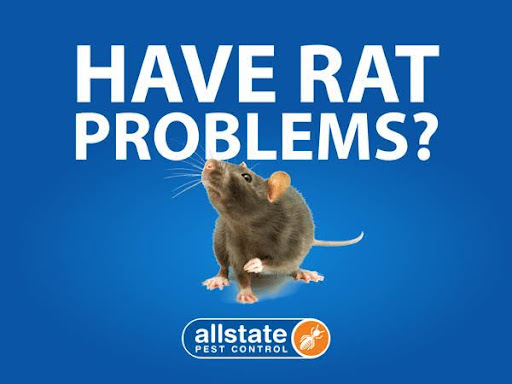
Final Thoughts
Rat droppings might seem like just a mess to clean, but they’re often the first warning sign of something more serious. If you’ve started to find rat poop regularly in your home or business, it’s time to act, not just to clean, but to prevent it.
Allstate Pest Control has nearly 40 years of experience helping South Australians manage rodents, recover safely from pest infestations, and breathe easier. Got questions? We’re just a call away, 24/7.



